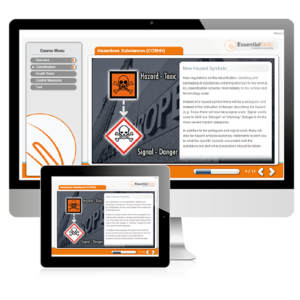COSHH Explained: Control of Substances Hazardous to Health
Every year, thousands of workers are made ill by exposure to hazardous substance. These illnesses range widely from lung cancer to skin disease, costing millions of pounds to society and industry.
What Does COSHH Stand For?
COSHH stands for the Control of Substances Hazardous to Health. Under the Control of Substances Hazardous to Health Regulations (2002) employers are required to control their employees’ exposure to chemicals and other substances that are harmful to health and therefore, reduce or prevent illness.
By following these COSHH regulations, your organisation will help retain fit and healthy employees and ensure the financial health of your business.
Hazardous substances can come in many forms and exposure can occur via inhalation, skin contact, by other routes including the transferring of chemicals by unwashed hands and through eating and smoking. Dust particles and splashes of caustic fluid can cause severe eye irritation.
________________________________________________________________________________________________________
COSHH in the workplace: When Was COSHH Introduced?
COSHH developed as key part of health and safety practice for a number of reasons. Initially, the Health and Safety at Work Act 1974 was the primary piece of legislation that outlined the dual role that employers and employees play in maintaining workplace safety. Although the HSWA addresses hazardous substances in the workplace, it does so broadly, and does not go in detail about its management. As a result, the Control of Substances Hazardous to Health Regulations came in to effect in 2002 in order to place specific focus on the dangers associated with hazardous substances, and the steps that employers and employees should take to manage and reduce risk.
________________________________________________________________________________________________________
What Does COSHH Cover? 
A number of hazardous substances and are governed
- Chemicals
- Products containing chemicals
- Fumes
- Dusts
- Vapours
- Mists
- Nanotechnology
- Gases and asphyxiating gases and
- Biological agents (germs). If the packaging has any of the hazard symbols then it is classed as a hazardous substance.
- Germs that cause disease such as leptospirosis or legionnaires disease and germs used in laboratories.
The regulations, however, do not cover asbestos, lead or radioactive substances. These are covered under their own, specific legislation.
The most common hazards will depend on your business/industry type. If you operate within a woodwork factory, metal finishers or a quarry, exposure to hazardous dust particles and fumes can cause lung disease, dermatitis and asthma. Additionally, materials such as flour and wood dust can ignite and potentially explode.
Everyday substances that can cause harm are all around us, both at work and at home. Are you aware that some glue, ink, detergent and beauty products all hold hidden dangers? Used correctly however, according to the manufacturer’s instructions and in line with current regulations, they are unlikely to cause harm to health.
There is therefore, a very real need for all employers to understand how to assess their individual businesses and the substances used by their workforce. Risk assessments and control measures should be implemented to reduce potential exposure.
________________________________________________________________________________________________________
COSHH Explained: What Can You Do?
Guidance on Control of Substances Hazardous to Health can be found by visiting the Health and Safety Executive (HSE) website.
Online COSHH training courses are an excellent way of raising awareness among your workforce. The VinciWorks Hazardous Substances (COSHH) online course highlights the key responsibilities that employers and their workforce have in relation to hazardous substances and COSHH in the workplace. The online course explains what hazardous substances are, explores substance classification and hazard classification symbols, both old and new, along with the importance of labelling and safety data sheets.
The course outlines how hazardous substances can impact on human health, how they enter the body, symptoms and specific health conditions. It also details actions to take to control the risks from hazardous substances, such as the use of personal protective equipment, and ways to deal with accidents and emergencies.
As with all the VinciWorks courses, the Hazardous Substances (COSHH) eLearning course can be tailored to your needs, meaning that your employers ca n learn about substances and responses that are specific to your organisation. A designated course administrator can edit the text and images within the course using our integrated authoring tool, and link to organisation-specific documentation, all at no extra cost.
n learn about substances and responses that are specific to your organisation. A designated course administrator can edit the text and images within the course using our integrated authoring tool, and link to organisation-specific documentation, all at no extra cost.
Need to train more than 100 employees in COSHH? Click here for a quote
If you have fewer than 100 employees requiring training, access our PAYG eLearning shop here



